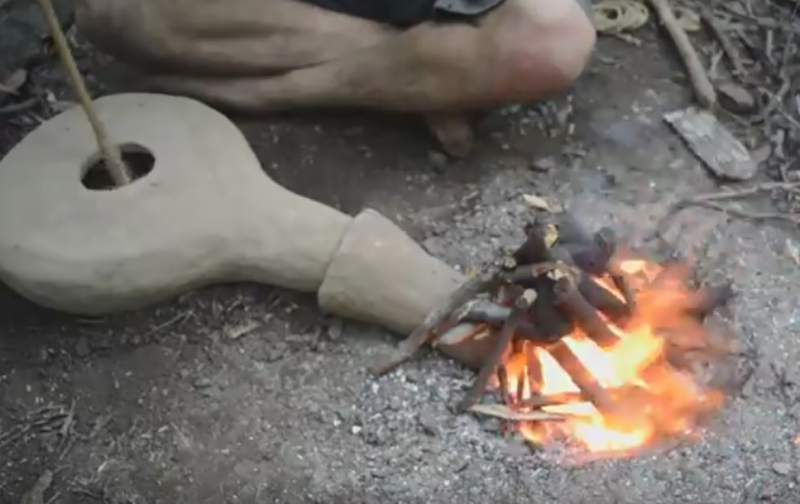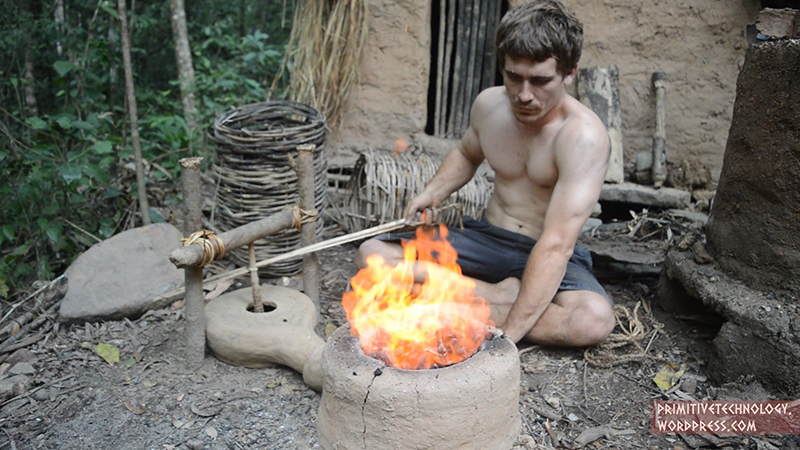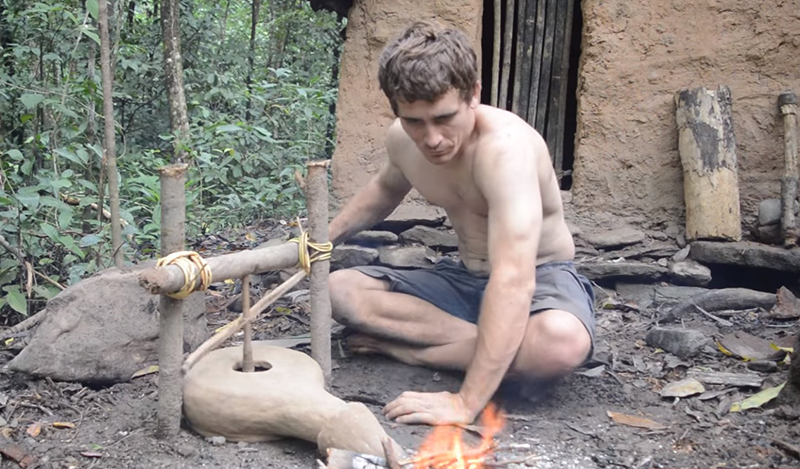I invented the Bow Blower, a combination of the bow drill and forge blower to make a device that can force air into a fire while being easy to construct from commonly occurring natural materials using only primitive technology. I began by fanning a fire with a piece of bark to increase its temperature. It is this basic principle I improved on throughout the project.
Next, I made a rotary fan from two pieces of bark that slot together at right angles to each other to form a simple 4 bladed paddle wheel about 20 cm in diameter and 5 cm tall. The blades of the fan were not angled and were designed only to throw air outwards away from the axle when spun. The rotor of the fan was made by splitting a stick two ways so it formed 4 prongs. The fan was then inserted into the prongs and the end lashed to hold it in place.
Spinning the fan rotor back and forth between the palms of the hands fanned the fire. But only some of the wind generated by the fan reached the fire. The rest of it was blowing in other directions, effectively being wasted…

So I built a fan housing from unfired clay to direct the air flow into the fire. This was basically an upturned pot with a hole in the top, a spout coming out of the side. The housing was about 25 cm wide and 8 cm tall. The hole in the top and the spout were both about 6 cm in diameter so that the air coming in roughly equaled the air coming out. The base of the fan rotor sat in a wooden socket placed in the ground to make it spin easier and the top of the rotor protruded from the hole in the top of the housing.
Now when the fan spun, air entered the hole in the top of the housing and exited the spout in the side. Importantly, it doesn’t matter which way the fan spins, air always goes into the inlet and out the spout. Air is thrown out towards the walls of the housing and can only leave through the spout while the vacuum in the centre sucks new air into the housing through the inlet. A separate clay pipe called a tuyere was made to fit over the spout to direct air into the coals. This was done because the pipe that touches the fire can melt away so it’s better to make this part replaceable.
Instead of making a large wheel and belt assembly to step up the speed of rotation, I opted for a 75 cm long bow…

I made a frame to hold the rotor in place consisting of two stakes hammered into the ground with a socketed cross bar lashed on to hold the top of the rotor. I made bark fiber cordage and tied the end to a stick. I then looped the cord around the rotor and held the other end in the same hand holding the stick. I then pushed and pulled the bow causing the rotor to spin rapidly, forcing air into the fire.
I made a simple mud furnace for the blower. Then I collected orange iron bacteria from the creek (iron oxide), mixed it with charcoal powder (carbon to reduce oxide to metal) and wood ash (flux to lower the melting point) and formed it into a cylindrical brick. I filled the furnace with charcoal, put the ore brick in and commenced firing. The ore brick melted and produced slag with tiny, 1mm sized specs of iron through it.
My intent was not so much to make iron but to show that the furnace can reach a fairly high temperature using this blower. A taller furnace called a bloomery was generally used in ancient times to produce usable quantities of iron and consumed more charcoal, ore and labour.
This device produces a blast of air with each stroke of the bow regardless of whether it is pushed or pulled. The bow makes it possible to operate the blower without using a complicated belt and wheel assembly used in traditional forge blowers. There is a brief pause at the end of each stroke where the fan stops to rotate in the other direction, but this is effectively no different to the intermittent blast of a double acting bellows of Europe or box bellows of Asia.
The materials used (wood, bark, bark fibre and clay) are readily available on most continents. No leather, valves or precisely fitted piston gaskets are required as with other types of bellows. The cords for this device wear out often so a number of back up cords should be kept handy for quick replacement. In summary, this is an easy to make device that solves the problem of supplying forced combustion air required for high temperature furnaces and forges.
You can check out the entire process in the video below…
If you like this idea, be sure to share it with your friends and inspire someone you know. Anything becomes possible with just a little inspiration…

